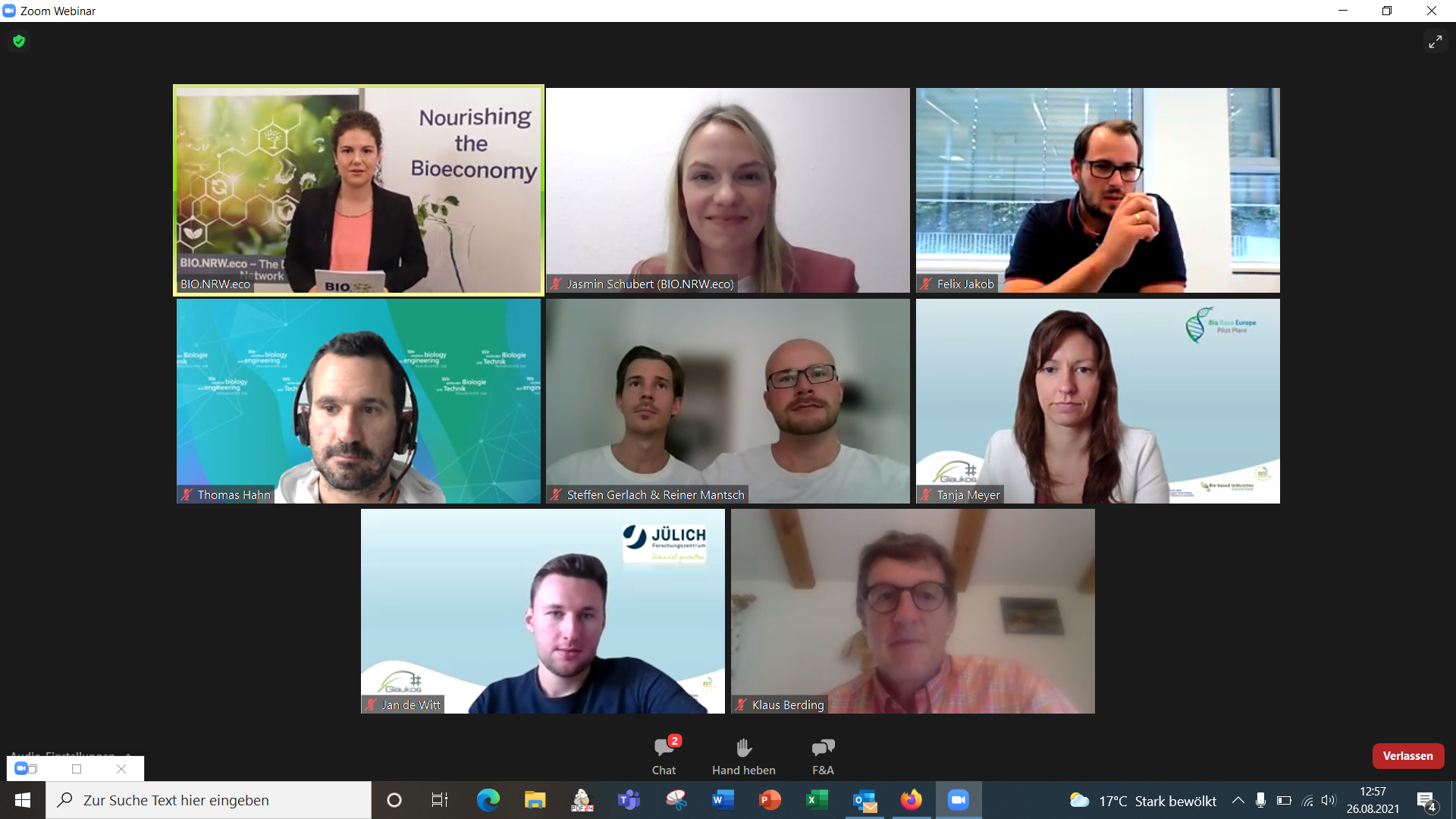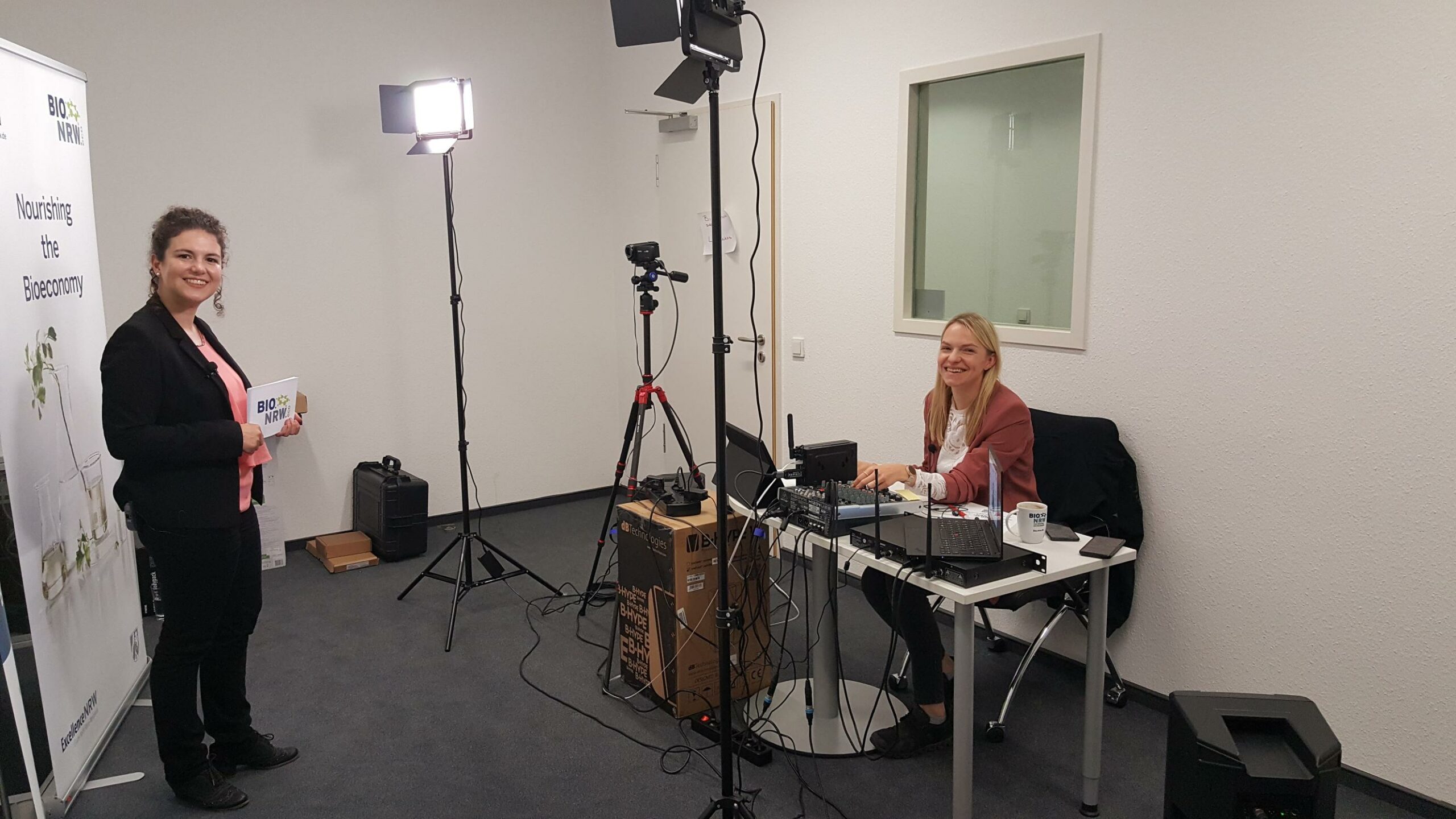
Diverse innovations for a sustainable textile industry
High turnover but low sustainability
The fashion industry is a major global economic player accounting for 2 % of global GDP. But it is also the second-largest polluting industry in the world.
Klaus Berding from the GEMIT Institute at Hochschule Niederrhein University of Applied Sciences put it in a nutshell at the BIO.NRW webinar “Innovations for a New Textile Industry”. He spoke about how the textile industry is responsible for 10 % of global carbon emissions and how it causes considerable water pollution through the use of toxic chemicals and the release of microplastics. In addition, the fast fashion industry uses primarily toxic dyes and additives as well as cheap mixtures of fibres that cannot be recycled. Over 80 % of the clothes are either combusted or end up in landfills, he reported.
We need to create a new textile industry
To counteract the negative consequences, the textile industry must be converted from a linear economy into a circular economy that includes the producers as well as the consumers. Consumer awareness of sustainability has increased over the last few years, and so too has the demand for sustainable textiles. The consumer is therefore a considerable factor when it comes to transforming the industry. The need to act has also been recognized by policy makers. In the Circular Economy Action Plan, the European Commission announced a comprehensive EU Strategy for Textiles for 2021: “The strategy will aim at strengthening industrial competitiveness and innovation in the sector, boosting the EU market for sustainable and circular textiles, including the market for textile reuse, addressing fast fashion and driving new business models.”
Multifaceted innovations will drive the transformation
The transformation of the textile industry will only be possible through new technologies that will provide an alternative to existing processes and make the value chains transparent. Textile recycling, for example, is still only at an early stage, but it will become an important element in the circular textile economy, according to Berding.
Matthias Fuchs, CEO of OceanSafe, emphasized how important it is that the development of products takes into account what will happen to these products after they have been used. In his presentation, he outlined his company’s textile component kit, which can be used by textile manufacturers in existing fabrication plants to produce non-toxic and biodegradable textiles. The kit is circular thanks to OceanSafe’s “take back” system. The old textiles are industrially composted and processed into new raw materials.
The topic of recycling textiles is also the primary focus of Eeden, a start-up founded by Reiner Mantsch and Steffen Gerlach. In their talk, they presented a chemical upcycling process for cellulose-based textile waste. What makes this particularly sustainable is that the chemicals used and the side streams created are reprocessed and fed back into the process. The resulting pulp can be used as a raw material for new textiles.
Recycling can also be done biotechnologically. Jan de Witt from Forschungszentrum Jülich talked about biorecycling, which involves the microbial and enzymatic degradation of polymers and coatings. The resulting building blocks can then be reused in microbial upcycling to create new materials and thus close the cycle.
However, the optimization of material cycles is not the only important factor for a sustainable textile industry. The dyeing and finishing processes of textiles are also extremely harmful to the environment. They are characterized by high water consumption and the use of toxic chemicals and dyes. Here too, companies and research institutes have developed versatile approaches to optimize these processes, which were presented in this webinar.
First, Dr. Chralie Gilbert of the start-up Colorifix (UK) spoke about the biotechnological production of pigments. He described how Colorifix uses synthetic biology to create microbial strains that can produce different pigments. This means that the use of heavy metals and organic solvents can be dispensed with.
Dr. Thomas Hahn from the Fraunhofer Institute IGB presented the applications of the polysaccharides chitin and chitosan in textile processing. The possible uses are manifold: as a sizing agent, in fibre spinning, or even in the purification of textile waste water. The raw material made from insects, crustaceans, or mushrooms can be obtained from side streams in the food and animal feed industries.
The use of peptides as building blocks for textile coatings was presented by Dr. Felix Jakob from the Leibniz Institute for Interactive Materials. In his presentation, he explained how peptides can bind to textile surfaces and thus impart water-repellent and antimicrobial properties. Even the dyeing of surfaces is possible. At the moment, toxic compounds are often used to perform these functions.
The event presented potential solutions for sustainable textile value creation
The webinar made it clear that biotechnology offers diverse approaches and solutions for creating sustainable alternatives in textile finishing and recycling. These are supplemented by chemical processes and the use of bio-based raw materials from residual and side streams. The webinar demonstrated that innovative start-ups and collaborative project work between various research institutions lead to creative approaches and new processes, which will pave the way for the transition to a circular textile economy. The audience praised the wide range of topics covered by the event, describing the webinar as diverse and varied, with a good mix of interesting presentations from research and industry.
We are delighted that the audience enjoyed the presentations and that first contacts between the speakers and audience have been arranged to follow up on possible collaborations. Therefore, we would like to thank the great speakers and the interested audience.
We also thank BIO Clustermanagement NRW GmbH for their support in implementing the webinar.
High turnover but low sustainability
The fashion industry is a major global economic player accounting for 2 % of global GDP. But it is also the second-largest polluting industry in the world.
Klaus Berding from the GEMIT Institute at Hochschule Niederrhein University of Applied Sciences put it in a nutshell at the BIO.NRW webinar “Innovations for a New Textile Industry”. He spoke about how the textile industry is responsible for 10 % of global carbon emissions and how it causes considerable water pollution through the use of toxic chemicals and the release of microplastics. In adittion, the fast fashion industry uses primarily toxic dyes and additives as well as cheap mixtures of fibres that cannot be recycled. Over 80 % of the clothes are either combusted or end up in landfills, he reported.
We need to create a new textile industry
To counteract the negative consequences, the textile industry must be converted from a linear economy into a circular economy that includes the producers as well as the consumers. Consumer awareness of sustainability has increased over the last few years, and so too has the demand for sustainable textiles. The consumer is therefore a considerable factor when it comes to transforming the industry. The need to act has also been recognized by policy makers. In the Circular Economy Action Plan, the European Commission announced a comprehensive EU Strategy for Textiles for 2021: “The strategy will aim at strengthening industrial competitiveness and innovation in the sector, boosting the EU market for sustainable and circular textiles, including the market for textile reuse, addressing fast fashion and driving new business models.”
Multifaceted innovations will drive the transformation
The transformation of the textile industry will only be possible through new technologies that will provide an alternative to existing processes and make the value chains transparent. Textile recycling, for example, is still only at an early stage, but it will become an important element in the circular textile economy, according to Berding.
Matthias Fuchs, CEO of OceanSafe, emphasized how important it is that the development of products takes into account what will happen to these products after they have been used. In his presentation, he outlined his company’s textile component kit, which can be used by textile manufacturers in existing fabrication plants to produce non-toxic and biodegradable textiles. The kit is circular thanks to OceanSafe’s “take back” system. The old textiles are industrially composted and processed into new raw materials.
The topic of recycling textiles is also the primary focus of Eeden, a start-up founded by Reiner Mantsch and Steffen Gerlach. In their talk, they presented a chemical upcycling process for cellulose-based textile waste. What makes this particularly sustainable is that the chemicals used and the side streams created are reprocessed and fed back into the process. The resulting pulp can be used as a raw material for new textiles.
Recycling can also be done biotechnologically. Jan de Witt from Forschungszentrum Jülich talked about biorecycling, which involves the microbial and enzymatic degradation of polymers and coatings. The resulting building blocks can then be reused in microbial upcycling to create new materials and thus close the cycle.
However, the optimization of material cycles is not the only important factor for a sustainable textile industry. The dyeing and finishing processes of textiles are also extremely harmful to the environment. They are characterized by high water consumption and the use of toxic chemicals and dyes. Here too, companies and research institutes have developed versatile approaches to optimize these processes, which were presented in this webinar.
First, Dr. Chralie Gilbert of the start-up Colorifix (UK) spoke about the biotechnological production of pigments. He described how Colorifix uses synthetic biology to create microbial strains that can produce different pigments. This means that the use of heavy metals and organic solvents can be dispensed with.
Dr. Thomas Hahn from the Fraunhofer Institute IGB presented the applications of the polysaccharides chitin and chitosan in textile processing. The possible uses are manifold: as a sizing agent, in fibre spinning, or even in the purification of textile waste water. The raw material made from insects, crustaceans, or mushrooms can be obtained from side streams in the food and animal feed industries.
The use of peptides as building blocks for textile coatings was presented by Dr. Felix Jakob from the Leibniz Institute for Interactive Materials. In his presentation, he explained how peptides can bind to textile surfaces and thus impart water-repellent and antimicrobial properties. Even the dyeing of surfaces is possible. At the moment, toxic compounds are often used to perform these functions.
The event presented potential solutions for sustainable textile value creation
The webinar made it clear that biotechnology offers diverse approaches and solutions for creating sustainable alternatives in textile finishing and recycling. These are supplemented by chemical processes and the use of bio-based raw materials from residual and side streams. The webinar demonstrated that innovative start-ups and collaborative project work between various research institutions lead to creative approaches and new processes, which will pave the way for the transition to a circular textile economy. The audience praised the wide range of topics covered by the event, describing the webinar as diverse and varied, with a good mix of interesting presentations from research and industry.
We are delighted that the audience enjoyed the presentations and that first contacts between the speakers and audience have been arranged to follow up on possible collaborations. Therefore, we would like to thank the great speakers and the interested audience.
We also thank BIO Clustermanagement NRW GmbH for their support in implementing the webinar.

